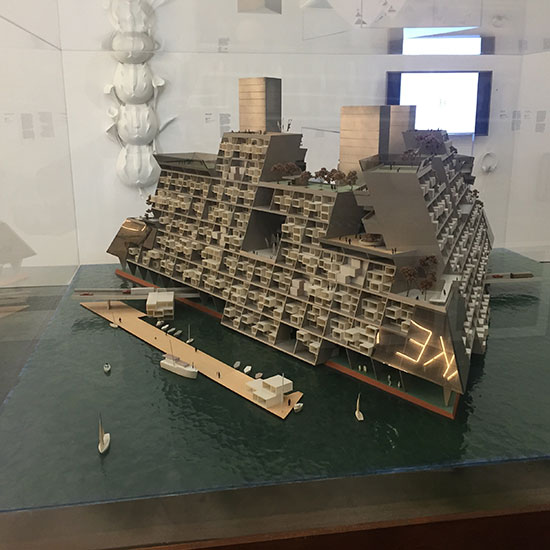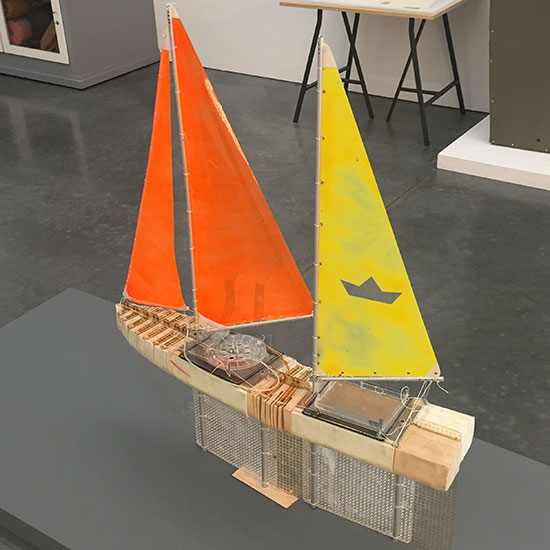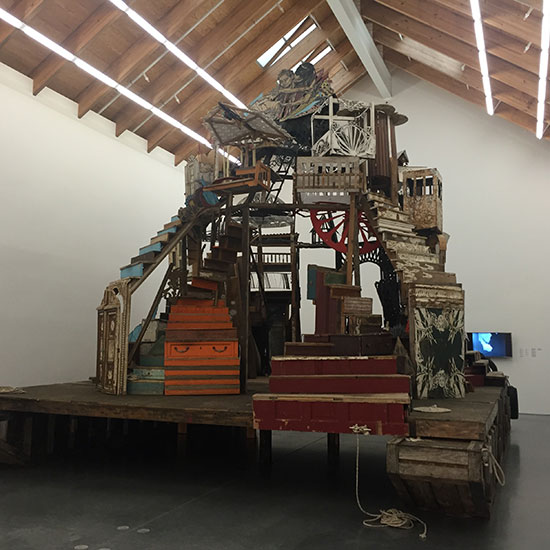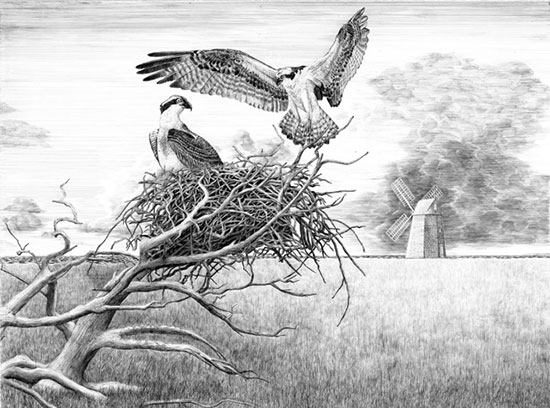“Radical Seafaring” at the Parrish Art Museum in Water Mill offers a cogent illustration that challenging and thought provoking exhibitions need not be completely successful to be considered an unqualified success.
To understand the validity of this notion, it’s important to understand that, in the realm of curatorial priorities, it’s relatively easy to play it safe and develop themes that are simple to present and for an audience to understand. But it is significantly more satisfying (as in this case) to confront viewers with complex concepts and ideas that demand more than pretty pictures assembled based on pedestrian perceptions.
As the avant-garde musician and composer Brian Eno once noted, the most interesting art and music is a result of establishing “a situation that presents you with something slightly beyond your reach.”
In the case of “Radical Seafaring,” the sense of experiencing something slightly beyond one’s reach arises, in no small part, because so much of the exhibit is presented in photos and films of performance and installation. This approach allows for significant impact on the viewer and helps propel the overall narrative. At the same time, though, it falls short of imparting a sense of aesthetic involvement on the audience’s behalf and, instead, conjures a more voyeuristic sensibility.
This is an observation that some might justifiably categorize as an insignificant cavil that misses the whole point of site specific endeavors. Nonetheless, even if there are elements of the exhibition that left an aftertaste of frustration for this reviewer, it is, at the same time, one of the most ambitiously inspiring and edifying presentations at the Parrish since 2001’s exhibit “About the Bayberry Bush.”
Featuring projects dating from 1968 to 2016, the exhibition is organized around four themes: Exploration—the quest for new experiences; Liberation—self-reliance, the desire to shape one’s world, and utopian impulses; Fieldwork—hands-on, methodological information-gathering about the environment; and Speculation—using waterways as the stage upon which to build other realities.
Curator Andrea Grover conjures an immediate connection throughout the exhibit between what she refers to as “offshore art” and the environmentally based Land Art movement embodied by the late Robert Smithson. This underlying theme is particularly timely given the growing impact of climate change on sea levels around the globe and the potentially catastrophic results. Even so, “Radical Seafaring” never yields to any sensationalist atmosphere of hysteria. Instead, throughout the exhibit the emphasis is on how artists are responding to growing conservation concerns in terms of seeking solutions through new and imaginative existential approaches.
This kind of approach is perhaps best embodied in Buckminster Fuller’s Triton City (model, 1968) which furthered the interest of the inventor of the geodesic dome in finding new avenues of improving the sustainability of modern society in an ecologically challenged world. Designed to accommodate up to 100,000 people and determined by the U.S. Navy’s Bureau of Ships to be completely seaworthy, the design is based on connected tetrahedron structures. The full-scale Triton City was originally designed to be installed in Tokyo Bay and tied to the mainland by a series of bridges.
.

"Triton City," model by Buckminster Fuller, 1968.
.
This approach of problem solving in a changing world is also evident in The Great Salt Lake Exploration Platform (model and two archival pigment prints, 2015) by the Center for Land Use Interpretation, Steve Badgett, and Chris Taylor model. Another good example is Cesar Harada’s Protei 010.9 Mini Cargo (acrylic, polycarbonate, EVA foam, stainless steel, 2 Towerpro MG95 Digi Hi Speed motors, 4 AA batteries, and nylon cord, 2014).
.

"The Great Salt Lake Exploration Platform," model by Center for Land Use Interpretation, Steve Badgett, and Chris Taylor, 2015.
.

"Protei 010.9 Mini Cargo" by Cesar Harada, 2014. Acrylic, polycarbonate, EVA foam, stainless steel, 2 Towerpro MG95 Digi Hi Speed motors, 4 AA batteries, and nylon chord.
.
Also of particular interest is a monumental work by an artist named Swoon titled Hickory (mixed media, 2009) which physically dominates the main gallery at the Parrish. An impressive collection of found objects, wood, furniture, and myriad other components, the piece, in the words of the artist and writer Choo Ai Loon, is “a real boat that seems to have sailed out of a fantasy.”
.

"Hickory" by Swoon, 2009. Mixed media.
.
The only problem with this work, though, is that its size makes it difficult to view the remarkable drawings by Scott Bluedorn that hang nearby. Featuring four works from his series Forbidden Islands (including Plum, Gardiners, and Great Gull islands), the pieces echo with the timelessness of the natural world as well as mysteries of our environment about which humans can only speculate. As the author Christopher Paolini wrote, the sea “defies all attempts to capture it with words and rejects all shackles. No matter what you say about it, there is always that which you can’t.”
.

"Plum Island" by Scott Bluedorn, 2016. Ballpoint pen on paper, 33.5 x 45 inches.
.

“Gardiners Island” by Scott Bluedorn, 2016. Ballpoint pen on paper, 33.5 x 45 inches.
.
Also of interest in the exhibit at the Parrish Museum are Duke Riley’s Curtains for the Free World (ink on canary paper, 2007), Michael Combs’s Daisy Chain (hand carved and painted cedar and linden wood, 2016), Ant Farm’s Dolphin Embassy 2 (sepia print, 1975), and Bruce High Quality Foundation’s Raft of the Medusa (digital chromogenic print, 2004).
___________________________
BASIC FACTS: “Radical Seafaring—A Survey of Artist Initiated, Site-Specific Works on the Water” is on view May 8 through July 24, 2016 at the Parrish Art Museum, 279 Montauk Highway, Water Mill, NY 11976. www.parrishart.org
___________________________
Copyright 2016 Hamptons Art Hub LLC. All rights reserved.
